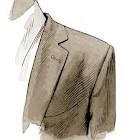Commercial patterns are great. They give an easy guide to sewing a garment. However, people are not cookie cutter to the pattern numbers (i sure am not) and to achieve better fit they need to be altered.
Here are some easy and basic alterations you can use to achieve great fit.
When choosing a pattern, choose a top based on your bust measurement and a skirt or bottom based on your full hip because these are the most difficult to alter.
I will be using a basic two dart sleeveless bodice that I've copied off.
1. Altering the waist
The waist is a common area that needs adjustment and is easy to achieve.
First thing to do is measure your pattern to compare to your own waist measurement.
When you measure your pattern, measure right on the waist line and make sure you don't include your seam allowance or your darts. These will be enclosed within you garment and won't add to the width of the waist. measure the front and back, add them together then double them because the pattern only covers one side of the body.
 |
| Measureing front |
Once you have compared you waist measurement to the pattern, you will either add or take away from the pattern.
 |
| Measureng Back |
For an easy example: let's say your waist is 30" and your pattern measures 25". 30-25=5 so you would need to add 5" to add for your waist measurement, plus 1" for fitting ease so it's not skin tight. That's 6" total. Add additional width for design ease depending on the style of the garment. If its a tunic, you'll want more fitting ease than a closer fitting tank.
This 5" need to be added to the pattern all the way around. So you need to divide the measurement by 4. One fourth for each side seam (two front side seams and two back side seams).
So you will add 1 1/2" to each side seam.
Once you have measured and determined how much you should add, tape a wedge (the 1 1/2" at the waist and taper to nothing at the arm side so you don't make your arm hole 3" bigger) piece of paper or copy the pattern like I have and draw the 1 1/2" to both the front and the back.
To make a pattern smaller, do the same thing with the wedge but cut away the pattern.
(make sure you adjust your seam allowance)
2. Lengthing or shortening your bodice
Depending on your body proportions, a top can be too short or too long to fit or for just personal preference. Adding to the length is just as easy as the width.
first measure yourself to compare to the pattern. Measure down your center front from where the neckline hits to your waist or high hip (depending on where your top hits). Then measure down your pattern.
 |
Measuring down the front bodice
|
Comparing your body measurement to the top measurement, add or subtract the difference between yourself and the bodice. (BE CAREFUL! Make sure you leave your hem or seam allowance and hem in!)
So say you want to add 2 inches to the length of your bodice. you would transfer a two inch strip following the line of the center front and angle of the sideseam. You may want to re measure the waist to make sure you dont take or add to the measurement.
Not too bad is it? i hope this helps!
























